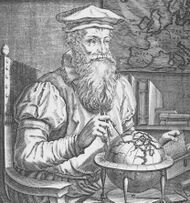Geographer

A geographer is a physical scientist, social scientist or humanist whose area of study is geography, the study of Earth's natural environment and human society, including how society and nature interacts. The Greek prefix "geo" means "earth" and the Greek suffix, "graphy", meaning "description", so a geographer is someone who studies the earth.[1] The word "geography" is a Middle French word that is believed to have been first used in 1540.[2]
Although geographers are historically known as people who make maps, map making is actually the field of study of cartography, a subset of geography. Geographers do not study only the details of the natural environment or human society, but they also study the reciprocal relationship between these two. For example, they study how the natural environment contributes to human society and how human society affects the natural environment.[3]
In particular, physical geographers study the natural environment while human geographers study human society and culture. Some geographers are practitioners of GIS (geographic information system) and are often employed by local, state, and federal government agencies as well as in the private sector by environmental and engineering firms.[4]
The paintings by Johannes Vermeer titled The Geographer and The Astronomer are both thought to represent the growing influence and rise in prominence of scientific enquiry in Europe at the time of their painting in 1668–69.
Areas of study
Subdividing geography is challenging, as the discipline is broad, interdisciplinary, ancient, and has been approached differently by different cultures. Attempts have gone back centuries, and include the "Four traditions of geography" and applied "branches."[5][6][7]
Four traditions of geography
The four traditions of geography were proposed in 1964 by William D. Pattison in a paper titled "The Four Traditions of Geography" appearing in the Journal of Geography.[5][8] These traditions are:
- spatial or locational tradition[5][8]
- area studies or regional tradition[5][8]
- Human-Environment interaction tradition (originally referred to as the "man-land tradition")[5][8]
- Earth science tradition[5][8]
Branches of geography
The UNESCO Encyclopedia of Life Support Systems subdivides geography into three major fields of study, which are then further subdivided.[6][7] These are:
- Human geography: including urban geography, cultural geography, economic geography, political geography, historical geography, marketing geography, health geography, and social geography.[9]
- Physical geography: including geomorphology, hydrology, glaciology, biogeography, climatology, meteorology, pedology, oceanography, geodesy, and environmental geography.[10]
- Technical geography: including geoinformatics, Geographic information science, geovisualization, and spatial analysis.
Five themes of geography
The National Geographic Society identifies five broad key themes for geographers:
Notable geographers

- Alexander von Humboldt (1769–1859) – published Cosmos and founder of the sub-field biogeography.
- Milton Santos (1926–2001),He became known for his pioneering works in several branches of geography, notably urban development in developing countries.
- Arnold Henry Guyot (1807–1884) – noted the structure of glaciers and advanced understanding in glacier motion, especially in fast ice flow.
- Carl O. Sauer (1889–1975) – cultural geographer.
- Carl Ritter (1779–1859) – occupied the first chair of geography at Berlin University.
- David Harvey (born 1935) – Marxist geographer and author of theories on spatial and urban geography, winner of the Vautrin Lud Prize.
- Doreen Massey (1944–2016) – scholar in the space and places of globalization and its pluralities; winner of the Vautrin Lud Prize.
- Edward Soja (1940–2015) – worked on regional development, planning and governance and coined the terms synekism and postmetropolis; winner of the Vautrin Lud Prize.
- Ellen Churchill Semple (1863–1932) – first female president of the American Association of Geographers.
- Jovan Cvijić (1865–1927) – Serbian geographer, geologist, sociologist and human geographer; father of the karst geomorphology
- Eratosthenes (c. 276 – c. 195/194 BC) – calculated the size of the Earth.
- Ernest Burgess (1886–1966) – creator of the concentric zone model.
- Gerardus Mercator (1512–1594) – cartographer who produced the Mercator projection
- John Francon Williams (1854–1911) – author of The Geography of the Oceans.
- Karl Butzer (1934–2016) – German-American geographer, cultural ecologist and environmental archaeologist.
- Michael Frank Goodchild (born 1944) – GIS scholar and winner of the RGS founder's medal in 2003.
- Muhammad al-Idrisi (Arabic: أبو عبد الله محمد الإدريسي; Latin: Dreses) (1100–1165) – author of Nuzhatul Mushtaq.
- Nigel Thrift (born 1949) – originator of non-representational theory.
- Paul Vidal de La Blache (1845–1918) – founder of the French school of geopolitics, wrote the principles of human geography.
- Ptolemy (c. 100 – c. 170) – compiled Greek and Roman knowledge into the book Geographia.
- Radhanath Sikdar (1813–1870) – calculated the height of Mount Everest.
- Roger Tomlinson (1933 – 2014) – the primary originator of modern geographic information systems.
- Halford Mackinder (1861–1947) – co-founder of the London School of Economics, Geographical Association.
- Strabo (64/63 BC – c. AD 24) – wrote Geographica, one of the first books outlining the study of geography.
- Waldo Tobler (1930-2018) – coined the first law of geography.
- Walter Christaller (1893–1969) – human geographer and inventor of central place theory.
- William Morris Davis (1850–1934) – father of American geography and developer of the cycle of erosion.
- Yi-Fu Tuan (1930-2022) – Chinese-American scholar credited with starting humanistic geography as a discipline.
Institutions and societies
- American Association of Geographers[12]
- American Geographical Society[13]
- Anton Melik Geographical Institute (Slovenia)
- Gamma Theta Upsilon (international)
- Institute of Geographical Information Systems (Pakistan)
- International Geographical Union
- Karachi Geographical Society (Pakistan)
- National Geographic Society (US)[14]
- Royal Canadian Geographical Society
- Royal Danish Geographical Society
- Royal Geographical Society (UK)[15]
- Russian Geographical Society
See also
- Geographers on Film
- Geography
- Human geography
- List of geographers
- Outline of geography
- Physical geography
- Technical geography
References
- ↑ Arrowsmith, Aaron (1832). "Chapter II: The World". A Grammar of Modern Geography. King's College School. pp. 20–21. https://books.google.com/books?id=N1XWyAVQJh0C. Retrieved 4 October 2021.
- ↑ "geography (n.)" (Web article). Douglas Harper. n.d.. https://www.etymonline.com/word/geography.
- ↑ The History of Cartography, Volume 4: Cartography in the European Enlightenment. University of Chicago Press. 2020. pp. 557–558. ISBN 9780226339221. https://books.google.com/books?id=m9fkDwAAQBAJ. Retrieved 4 October 2021.
- ↑ "Geographers : Occupational Outlook Handbook : U.S. Bureau of Labor Statistics". https://www.bls.gov/ooh/life-physical-and-social-science/mobile/geographers.htm.
- ↑ 5.0 5.1 5.2 5.3 5.4 5.5 Pattison, William (1964). "The Four Traditions of Geography". Journal of Geography 63 (5): 211–216. doi:10.1080/00221346408985265. https://doi.org/10.1080/00221346408985265. Retrieved 27 August 2022.
- ↑ 6.0 6.1 Sala, Maria (2009). Geography Volume I. Oxford, United Kingdom: EOLSS UNESCO. ISBN 978-1-84826-960-6.
- ↑ 7.0 7.1 Sala, Maria (2009). Geography – Vol. I: Geography. EOLSS UNESCO. https://www.eolss.net/sample-chapters/c01/E6-14.pdf. Retrieved 30 December 2022.
- ↑ 8.0 8.1 8.2 8.3 8.4 Murphy, Alexander (27 June 2014). "Geography's Crosscutting Themes: Golden Anniversary Reflections on "The Four Traditions of Geography"". Journal of Geography 113 (5): 181–188. doi:10.1080/00221341.2014.918639.
- ↑ Nel, Etienne (2010-11-23). "The dictionary of human geography, 5th edition - Edited by Derek Gregory, Ron Johnston, Geraldine Pratt, Michael J. Watts and Sarah Whatmore". New Zealand Geographer 66 (3): 234–236. doi:10.1111/j.1745-7939.2010.01189_4.x. ISSN 0028-8144. http://dx.doi.org/10.1111/j.1745-7939.2010.01189_4.x.
- ↑ Marsh, William M. (2013). Physical geography : great systems and global environments. Martin M. Kaufman. Cambridge: Cambridge University Press. ISBN 978-0-521-76428-5. OCLC 797965742. https://www.worldcat.org/oclc/797965742.
- ↑ "Geography Education @". 24 October 2008. http://www.nationalgeographic.com/education/themes.html.
- ↑ Freeman, T. W.; James, Preston E.; Martin, Geoffrey J. (July 1980). "The Association of American Geographers: The First Seventy-Five Years 1904-1979". The Geographical Journal 146 (2): 298. doi:10.2307/632894. ISSN 0016-7398. http://dx.doi.org/10.2307/632894.
- ↑ "AGS History". 2009-02-26. http://www.amergeog.org/history.htm.
- ↑ "National Geographic Society". https://2009-2017.state.gov/p/io/unesco/members/48805.htm.
- ↑ "Royal Geographical Society - Royal Geographical Society (with IBG)". https://www.rgs.org/.
Further reading
- Steven Seegel. Map Men: Transnational Lives and Deaths of Geographers in the Making of East Central Europe. University of Chicago Press, 2018. ISBN 978-0-226-43849-8.
External links
{{Navbox | name = Geography topics | state = uncollapsed | title = Geography topics | bodyclass = hlist
| above =
| group1 = Branches | list1 =
{{Navbox|child
| bodyclass = hlist
| group1 = Human | list1 =
- Agricultural
- Behavioral
- Cultural
- Development
- Economic
- Health
- Historical
- Political
- Population
- Settlement
| group2 = Physical | list2 =
- Biogeography
- Coastal / Oceanography
- Earth science
- Earth system science
- Geomorphology / Geology
- Glaciology
- [[Earth:HydrologHydrology / Limnology
- Pedology (Edaphology/Soil science)
- Quaternary science
| group3 = Integrated | list3 =
}}
| group2 = Techniques and tools | list2 =
| group3 = Institutions | list3 =
- Geographic data and information organizations
- Geographical societies
- Geoscience societies
- National mapping agency
| group4 = Education | list4 =
| below =
}}
 |
